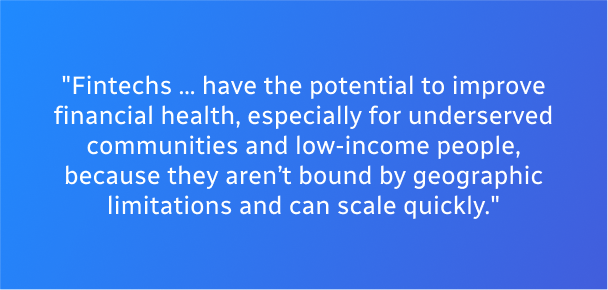BillGO regularly interviews our executive team; however, this summer we’re mixing things up and talking to thought leaders from across the industry.
Jennifer Tescher is the President and CEO of the Financial Health Network (FHN), a non-profit resource for business leaders, policymakers and others to improve the financial well-being of their customers, employees and communities. She’s also the host of the EMERGE Everywhere podcast, which features financial industry leaders who are “busting down silos to create an integrated financial health system for all.”
We asked Tescher to talk about how COVID-19 has impacted financial well-being as well as what the banking and payments industries can do to help promote financial health.
Tell us about the mission of the Financial Health Network.
The Financial Health Network is a recognized authority on financial health in the U.S. For the last 15 years we have been a trusted resource for business leaders, policymakers and innovators united in a mission to improve the financial health of their customers, employees and communities. Through research, advisory services, measurement tools and opportunities for cross-sector collaboration, we advance awareness, understanding and proven best practices in support of improved financial health for all.
Why is financial well-being such an important objective for the economy at large?
Financial health is when an individual can spend, save, borrow and plan in a way that helps them build financial resilience so they can weather shocks and pursue financial goals.
However, our research confirms many are struggling. For instance:
- The pandemic and recent recession had disastrous consequences for many Americans, especially low-income Americans, and Black, LatinX and women
- Black and Latinx communities continue to bear the brunt of the pandemic, with millions experiencing food and housing insecurity
- Financially-vulnerable Americans (including those with low incomes) tell us their financial situation has gotten worse during the last year
- People are struggling to afford healthcare, which may lead to long-term health consequences.
The pandemic made it especially challenging for people who live paycheck-to-paycheck to save. While stimulus payments helped many people weather the pandemic, those with lower incomes saw larger but more gradual increases in account inflows, suggesting that relief may have been slower to reach those who needed it most. Other data shows low- to moderate-income (LMI) frontline workers are less likely to be financially healthy than non-frontline workers, a reality that was likely exacerbated by the pandemic. To cope with the financial effects of the pandemic, LMI workers were more likely to worry about depleting their savings.
Access to mainstream financial services is important for financial well-being, but that access alone is not enough for people to be financially healthy. Financial services can help individuals manage their daily lives and build better futures, but a recent report we issued shows those least able to afford the costs associated with financial services are disproportionately shouldering those costs. This exacerbates financial distress and contributes to long-standing disparities.
What are the major barriers to improving the financial wellbeing for U.S. consumers?
There are several barriers and many of them are deep and structural: income inequity, lack of affordable housing, generational wealth gaps, access to affordable healthcare, public transportation to get people to their jobs – the list goes on.
Many people are so focused on paying necessary bills that they can’t focus on a holistic financial health plan where they can save more than they spend, set aside savings for the future and have access to credit that allows them to improve their financial lives.
While our country has many systems in place to address specific areas of concern such as affordable housing, financial regulations and economic investment in underserved communities, those systems rarely work together. This results in information silos. In order to address financial well-being in a holistic way and give all individuals a chance to achieve financial health, leaders from across industries must recognize its importance and come together to create dynamic solutions.
What projects is FHN undertaking at FHN to address these challenges?
I recently presented at an FHN event and spoke about how all of us can play a role in catalyzing a movement to drive systemic change that will improve financial health for all. This involves elements including broad engagement, measurement, leadership, partnerships and commitment.
A few of the program, projects and initiatives our team is working on with others in the industry include:
- Financial Health Pulse Trends Report, supported by Citi Foundation, which showed that last year only two-thirds of Americans were financially healthy - and that many were forced to borrow money or cut back on healthcare visits during the pandemic to make ends meet
- FinHealth Market Spend Report confirmed that financially-vulnerable households in the U.S. spend $255 billion just to cover the costs everyday financial services including fees and interest
- Recently the Worker Financial Wellness Initiative, a partnership between PayPal, JUST Capital, FHN and Good Jobs Institute, announced its first cohort of members: Chipotle, Chobani, Even, Prudential Financial, Verizon who are working to ensure their workers' financial security and well-being is a priority for both the C-suite and investors
We are also part of BlackRock’s Emergency Savings Initiative, a program from BlackRock’s social impact team. And in 2015, we launched the Financial Solutions Lab where we work with JPMC and Prudential to support and scale innovative ideas that help advance the financial health of low- to moderate-income communities, which are historically underserved.
What role can financial institutions (FIs) and fintechs play in advancing financial well-being in the U.S.?
We want to see providers of all kinds – from fintechs to large FIs – work to meet the needs of their customers by offering high-quality and affordable products that improve the financial well-being of consumers.
Incumbent FIs already have a large base of customers, and many already offer products that can be used to improve financial health. FIs often have scale to reach large populations of customers, and the pandemic caused many institutions to focus on their mobile products. Some are using technology or solutions developed by fintechs to better serve customers.
Fintechs also have the potential to improve financial health, especially for underserved communities and low-income people, because they aren’t bound by geographic limitations and can scale quickly. Many fintechs are hyper-focused on the user experience and can innovate and pivot more easily to address the needs of customers.

How can banking and payments change to support the financial well-being in the U.S.?
Banks and payments organizations can support the financial health of their customers and communities by putting the customer at the center and by treating customer financial health as the desired outcome.
An important part of this requires measuring the financial well-being of customers, as positive customer financial health translates into business success. If this was already widely happening, there would be a better match of products and services to customers’ specific needs, such as real-time payments for all, alternatives to overdraft, etc.
Low-barrier-to-entry products - such as low minimum balance checking accounts or secure cards - are other offerings that can benefit customers. Additionally, transparency around interest rates and fees enables consumers to make better-informed decisions about what they’re signing up for.
-2.jpg)

